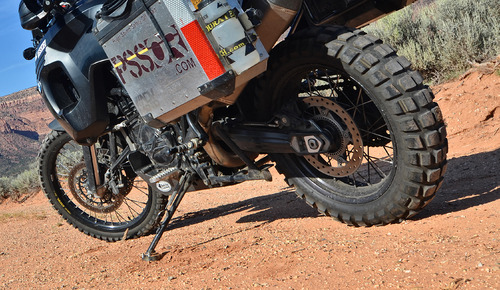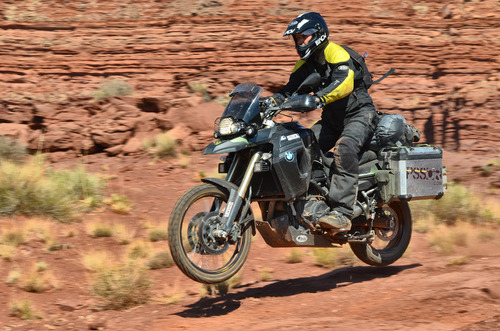
Overland Tech and Travel
Advice from the world's
most experienced overlanders
tests, reviews, opinion, and more
Are motocross boots overkill for your adventure?
The short answer is, yes. The long answer is, opinions may vary.
Chances are if you disagree with me, you are a more hard-core rider than I am. I ride big-bore BMWs off-road in rocky terrain, in the mud and sand when I have to, and on forest service roads that get me away from the main highway. But I leave demanding single-track and boulder hopping to the lighter bikes and the skilled riders who can maneuver a heavy, big cc motorcycle in technical terrain like it was an extension of their limbs. It’s just not my style of riding, although I am constantly impressed by those whose it is.
Still, I wanted to give motocross boots a try because of their protection. I see a lot of adventurers wearing hard-core boots, so I wanted to see what it was all about. It was an expensive lesson in what works and what I am comfortable in.
Six months ago I bought a pair of Gaerne SG-10s, based upon great reviews and that claimed “best comfort” for a motocross boot. While the latter proved to be true, more so what I found was that motocross style boots are too bulky for my kind of riding. They’re heavier weight than the “adventure style boots” that have hit the market in the past few years. When comparing 5 pounds per boot to 2.5 pounds per boot, it might not seem like a lot, but after a few hours of wear your feet may beg to differ. Luckily the options for motorcycle footwear are growing and manufacturers are listening to new demands. Every year, new adventure boots hit the market, whether they are original designs or re-vamping old styles with new and lighter materials.
One may argue that the protection is worth the weight. I would not disagree with them unless it hindered performance. For me, it did. More than once I found myself floundering for the gear shifter, or not able to move my feet in time away from a falling bike. When I ride, I like to feel the dexterity of my feet while shifting and have the agility to move out of the way of a 500lb motorcycle plunging toward the ground (which has been known to happen on occasion). Maybe with more time I could learn to work with them, but six months is long enough to decide whether I like it or not.
While the Gaerne’s were comfortable for a motocross style boot, they are a stiff boot and they leave a lot to be desired when walking for any length of distance. If I know I am going to do anything off the bike, then I bring my Sidi On-Roads. Age and use have made the leather of those boots soft and the soles worn down, and thus the most comfortable pair of boots I own. Unfortunately, there is little protection and waning life left in them and would not consider them for long distance or long duration travel.
The final deterrent for me considering taking a pair of motocross boots: they are not waterproof. Unless you are solely riding in the Atacama Desert, which receives less than 0.5” of rainfall each year, you are bound to encounter rain or river crossings. Where I live in Central America receives an annual average rainfall of 75” per year, so I must take this into consideration. Riding in wet gear is not nearly as bothersome as riding in wet boots. Soggy socks and clammy feet are so uncomfortable that I tear off my boots and drain my socks as soon as I get to a stopping point. There are alternatives such as Gore-Tex socks, but they don’t help the squish of a wet insole when you step down on it. That and the smell of wet Gore-Tex after a few days of use can get a little strong.
Although motocross boots did not work for me the way I expected, I would still use them for skills practice (I hope to one-day ride a big bike on single track, but that is many lessons away) and day rides when I know I will be on the bike the majority of the time. But if I am going to explore off the bike, I do not even consider taking them. I want a comfortable pair of boots with good protection. Is that too much to ask? It might be so, since I am still on the search for the perfect pair of boots for my motorcycle adventure.
For more motorcycle reviews and travel stories by Alison, check out: AlisonsWanderland.com
Improving a KLR650 with a Seat Concepts custom seat
I first met Lendon of Seat Concepts when the office was in a small warehouse in San Jacinto, California. At that time, the company had just started manufacturing molded foam replacements for motorcycle seats. Since most of its employees come from a motocross background, the company has a vested interest in creating comfortable seats.
Eighteen months later, I saw Lendon again at the Overland Expo in Flagstaff, AZ and was able to catch up on how the business has grown. Seat Concepts has moved to a larger warehouse and now manufactures not only the foam and seat covers, but the seat pans as well, for some of the most popular models of adventure motorcycle (such as the KLR650). He is swamped with orders these days, so I appreciate even more the time he spent with me during the installation of my custom Seat Concepts seat back in October 2012. I had visited the shop with my 2003 Kawasaki KLR650 just before leaving on a 16,000-mile journey from southern California to the tip of South America.
Ergonomics are a big part of preparing your motorcycle for long stretches of miles or lengths of time. Dialing in the right set-up is critical. Adjusting where your hands grip on the handlebars, where your feet rest on the footpegs, or where your rear end sits on the seat, is a personal venture. But you will know when it’s uncomfortable and needs to be changed. Your butt is most likely the first place to let you know. I have tried the stock seat, which my mass molded to its shape instead of the other way around. I have tried a Corbin flat seat, which was like vinyl wrapped plank of wood. Neither was very comfortable for longer than half a day. In searching for an auxiliary cushion, the only supplement I found was a sheepskin seat cover by Alaska Leather. Out of habit more than function, the sheepskin came with me to South America. It did not last to the end of the trip because it was worn thin by so many years of use.
Having a custom seat built was probably the best (and most comfort-conscious) decision I made for the journey. Read more >
23,000-mile review: Klim Latitude jacket and pants
 Pockets galore! (on the Altiplano in Peru)
Pockets galore! (on the Altiplano in Peru)
As a female motorcyclist, choosing a viable suit for long-term riding is met with limited options. Despite the growing industry for women’s gear, what was available in October of 2012 did not equate to the durability and versatility of men’s gear. I looked at comparable manufacturers such as Rev-it and Alpinestars (I rode a KLR, so the BMW brand was not even considered), but neither of those held up to what I wanted out of a suit I was going to live in for six months. So, while preparing for a motorcycle journey from Los Angeles, California to Ushuaia, Tierra del Fuego, I decided on Klim’s Men’s Latitude jacket and pants.
In my initial review after six days of test riding around California before I left, my response was, “Yay! Klim is so great!” But just like any new relationship, I was excited at the potential of what could be, not scrutinizing what I had in front of me. So now, 15-months and more than 23,000 miles later, it’s time to break down the long-term, grime-covered, down and dirty results...
 Latitude 0 (at the Equator in Ecuador)
Latitude 0 (at the Equator in Ecuador)
Continue reading full article here.
Schuberth C3 helmet: 12 months and 10,000 miles review
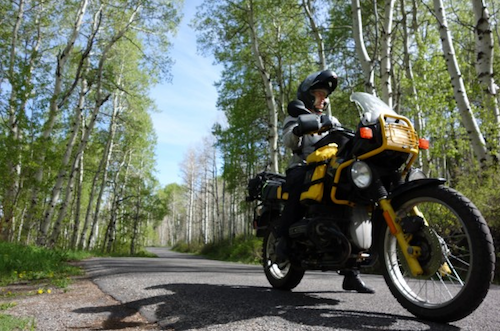
by Carla King, CarlaKing.com
My last helmet squeezed my jawbone, giving me a headache after about an hour. The previous one pressed on my left temple. Another rattled, another fell forward over my eyebrows, and yet another let a constant stream of air up the back of my neck. Helmets have made me itchy and sweaty, the visors have popped off, and the air flow controls have never quite worked properly. I've worn half-helmets, full helmets, modular helmets, dual-sport helmets, other people’s helmets, cheap helmets, medium-priced helmets, and expensive helmets. But in Spring of 2012 I started wearing a Schuberth C3, and since then I have stopped to look at a view, to ask directions, to fill up my gas tank, to buy snacks at a convenience store, to make phone calls and to take photos, all with my helmet still strapped on.
 WHY MODULAR?
WHY MODULAR?
I’ve always liked the idea of a modular helmet. I travel a lot and interact with people on the road, and it’s nice to be able to slide up the chin bar so people can see my face when I’m talking with them, especially when attempting a foreign language. But helmets have always been so uncomfortable that I've removed them every opportunity, sighing "aaahhhh" in relief from pressure-points, itching, and sweating. The Schuberth C3 is the first helmet I've owned that I don’t rip off my head as soon as the wheels stop turning, and that’s saying something, because I have been riding since I was a teenager.
Continue reading the full review here.
We will be running more motorcycle and equipment reviews from Carla, a longtime Overland Expo instructor and one of the most accomplished riders we know. Carla's been riding motorcycles since she was 14, and has ridden every kind of bike on most continents.
Tire review: Big Block Adventure
by Bret Tkacs, for Adventure Motorcycle Magazine
In early 2012, Kenda released the Big Block Adventure tire to compete in the emerging big-bike knobby market. ADVMoto put a set of Big Blocks to the test on the back trails of Baja, Mexico, and then continued north up the west coast to Washington state. Back then, the Big Blocks were good performers, and on par with the competition, but lacked mileage and shed their skins faster than other big-bike knobbies we’re accustomed to, such as the TKC80 and Metzler Karroo. Kenda took note of this and their engineers worked over the Big Block with a revised tread pattern and new compound.
The casual eye won’t see the difference, as the tread pattern looks very similar. The only way we could tell they were the new tires was by measuring the space between the tread blocks. The newer tires have a block pattern slightly tighter, which puts more rubber to the road/trail.
We recently mounted up our fresh set of tires and headed off to Moab to put them to the test. After riding 800 miles of jeep trails and gravel roads, as well as over 2,000 miles of pavement on our loaded test bike, the Big Blocks were still holding out.
The bottom line is that Kenda has a winner with good off-road performance, good street manners, and mileage that equals the competition. Highly recommended.
Pros:
- Still a top performer off-road
- Performs well for a knobby on the street
- Improved mileage over earlier version
- Price point winner
Cons:
- Less prestige than big name brands (ego)
- Like all big bike knobbies it has a short life span (equal to other knobbies, though)
Bret Tkacs works for PSSOR Training
Do you want it hard or soft? (your motorcycle luggage, that is)
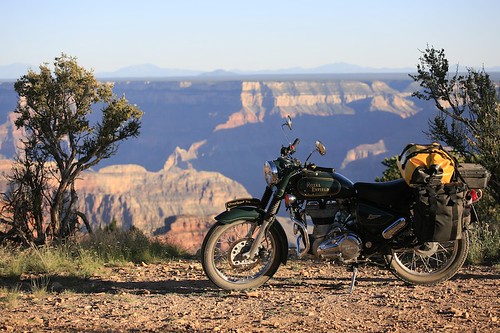 I equipped this test Royal Enfield with a combination of AndyStrapz canvas panniers, a Wolfman duffel, and a Pelican case rack trunk for a traverse of the Grand Canyon's North Rim
I equipped this test Royal Enfield with a combination of AndyStrapz canvas panniers, a Wolfman duffel, and a Pelican case rack trunk for a traverse of the Grand Canyon's North Rim
Just as our instinctive mental image of an expedition vehicle is more than likely a Land Rover 110 or Land Cruiser Troopie equipped with a roof rack loaded down with jerry cans and sand mats, so our image of an adventure motorcycle is likely to involve a giant BMW GS bulging with several square meters of aluminum sheet artfully folded and welded into rugged panniers and trunks covered with flag stickers from far-off places.
Thousands of the owners of these bikes have actually been to those far-off places. But how many riders chose those aluminum cases based solely on Long Way Round videos and magazine articles? How many remained satisfied with the approach after several thousand miles of travel? How many riders switch to soft luggage later on—and by the same token, how many riders start out with soft luggage and later switch to hard cases? Is there an overwhelming argument in favor of either, or is the choice simply a matter of trade-offs and priorities?
The debate has been the subject of endless forum threads begun by curious and innocent new riders. Replies generally fall into one of two categories: 1) “USE THE SEARCH FUNCTION!” or 2) Fifteen pages of opinions backed by rock-solid logic (and sometimes rock-solid experience) but little nuance. It’s either hard-luggage-is-the-only-way-to-go or soft-luggage-is-the-only-way-to-go.
The basic arguments for each are easily summarized. Soft luggage is less expensive, significantly lighter (with the equally important resultant benefit of a lower center of gravity), and not as likely to injure a foot or leg caught between luggage and ground during a spill or when working though rock gardens or sand. Soft luggage rarely requires special brackets to mount, generally results in a narrower bike profile, and can be compressed even further for shorter trips. If a soft pannier clips a rock or other obstacle during slow-speed maneuvering, it’s less likely to catch and throw the bike off balance.
Hard cases provide much better security from both outright theft and slash-and-grab attacks, are sometimes (but not always) more weatherproof, they sometimes can protect both rider and bike in a spill (as long as the situation described above doesn’t happen, and the luggage or its bracketing doesn’t damage the bike’s frame), and if easily removable can serve as seats or tables. Hard cases are easier to pack, provide better protection for fragile equipment, and can be modified easily with brackets for extra fuel canisters, etc.
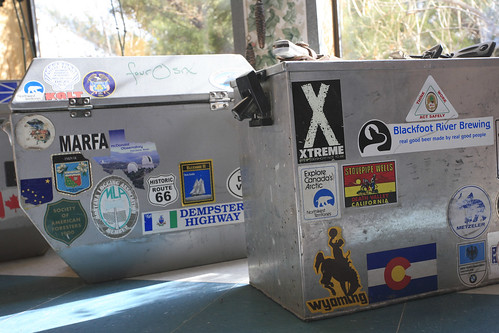 Doug Mote's hard cases, ready for "easy going."
Doug Mote's hard cases, ready for "easy going."
Summarizing arguments is easy, but it doesn’t make a choice any easier. What I wondered, and had never seen in any luggage threads except as vague hints, was if there might be a formula that would use easily quantifiable variables specific to the rider to point him or her in the right direction.
My own motorcycle luggage expertise (not counting long ago rides wearing a Camp Trails frame pack, which provided spectacular windage) is limited to the excellent canvas luggage from Andy Strapz, combined with an equally excellent Wolfman duffel, and a Pelican case pressed into service as a security trunk. The combination suited me perfectly, but I wanted to get input from those with far more extensive riding history. So I sent out a poll asking the question: hard or soft, and why? I hoped the results might coalesce into a logical hierarchy that would lead to a simple formula.
Those who shared their experience included Carla King, Tiffany Coates, Lois Pryce, Austin Vince, Doug Mote, Kevan Harder, Nicole Espinosa, Brian DeArmon, and Bruce Douglas. The result comprised what I considered to be a useful cross-section of the long-distance riding community—both sexes, and a mix of body sizes, travel styles, and motorcycle choices (from 250 to 1200 cc).
Indeed, as I began going through the responses from this vast pool of experience, definite trends became apparent. In the end I was able to come up with an algorithm accurate enough that I could plug in variables from almost any of the experienced riders I polled and correctly predict what kind of luggage he or she used in what situation.
Essentially (aside from your budget), I decided only three variables are necessary to determine which type of luggage will best suit you. While there is some gray area, in general I think most people will find themselves trending one way or the other. The variables are:
- Size of motorcycle
- Size of rider
- Difficulty of terrain
No earth-shaking revelations there, but the relationship between the three can shift things one way or another. The chart shows how the recommended choice shifts from hard (red) to soft (blue), with purple as the could-go-either-way middle ground.
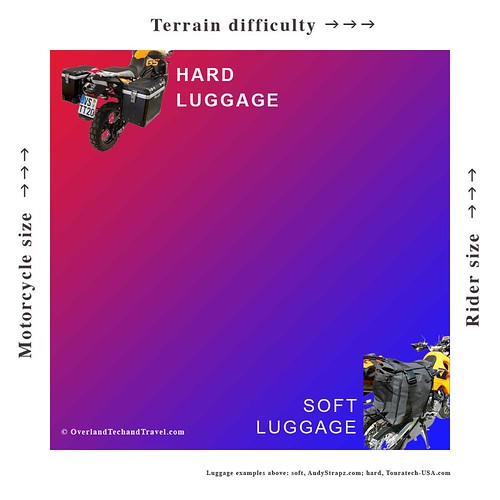
Simply explained, if you’re a big rider on a big bike and stick to asphalt or fairly well-maintained dirt roads, the advantages of hard luggage will most likely outweigh its disadvantages. Conversely, a small rider on a small bike who frequently challenges technically difficult routes would almost certainly be better off with soft luggage.
Some ambiguity arises if we start mixing and matching variables, but the observations of our experts still tilt the smart choice one way or the other. For example, small bikes—say under 650 cc—have a harder time coping with the weight and windage of hard luggage, regardless of terrain. Similarly, a big rider on a big bike who finds himself in central Africa during the rains, or deep in Egypt’s sand seas, or even on three-plus-rated 4x4 trails in the American West, will still benefit from the lighter weight, lower CG, and forgiving impact absorption of soft luggage.
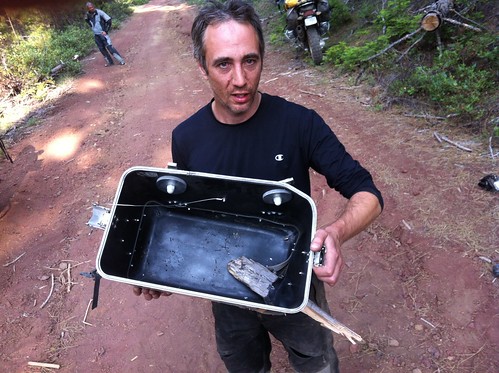 As filmmaker Sterling Noren recently found out, even anodized aluminum cases aren't impregnable
As filmmaker Sterling Noren recently found out, even anodized aluminum cases aren't impregnable
There’s also one more option to be considered regarding hard cases: While the Ewan-endorsed, steamer-trunk-sized aluminum cases represent the paradigm of hard luggage, lighter and smaller plastic cases, such as those offered by BMW for the F 650 GS, represent a viable middle ground in price, weight, and windage (and security). Another increasingly popular approach is to mount a small hard case such as a Pelican as a rack trunk, to provide security for cameras, laptops, and such, and go with soft cases for the rest of the luggage.
Here are some of the comments from our panel of experts, who collectively total a couple of million miles of motorcycle travel, including four circumnavigations.
Carla King’s motorcycle adventures began in 1995 with a 10,000-mile circumnavigation of the U.S. on a Ural with a sidecar, and haven’t stopped since. You can order the delightful book documenting the trip, along with her other published works, from her website here. Carla wrote, “Right now I’m setting up a new-to-me KLR, for which farkle options are famously infinite. After much research into cost, durability, security, convenience, and safety, I chose the Giant Loop soft luggage. Seems I can throw it on any bike, stuff almost any size and shape of thing into it, check it as luggage, and perhaps most importantly it’s not going to crunch my bones when I ride beyond my skill level and fall on (insert hard object here).”
Tiffany Coates set off on her first motorcycle trip, from the U.K. to India, with two months of riding experience. She has a bit more now—over 200,000 miles worth and counting, including the riding she did while filming a BMW unscripted commercial on Thelma, her much loved and well-used BMW R80GS. Tiffany still nurses the factory plastic cases that came on the bike, the latches of one of which long ago gave up trying to hold in the contents (small wonder - see photo below). According to her, “For me, the BMW plastic cases are ideal. Perfect size, with the ‘suitcase compression’ system which means I cram everything in and then sit on it (or two of us if we’re two up). Apparently we get more in these cases than the large metal ones due to the compression. Cheaper and lighter than metal cases and smaller—no risk of getting a leg caught under them if there is a fall. Also ultra-easy to unlock and whisk off the rack ready to carry into a hostel, or for emergency unloading in a river fall! As they are hard cases they are secure as well. I’m not anti-soft luggage, I have just never used it as the BMW panniers were on Thelma when I got her and so I never had a decision to make about what luggage to use.” Find out where Tiffany is now here.
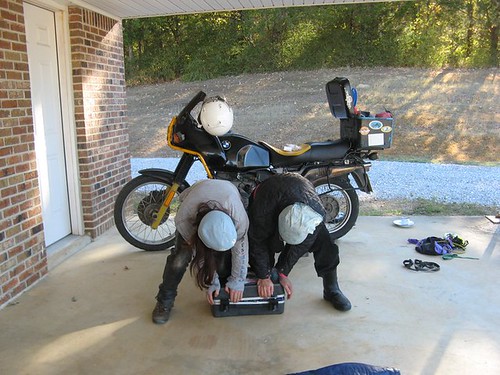 Tiffany and a friend do a little cargo compacting
Tiffany and a friend do a little cargo compacting
Lois Pryce couldn’t seem to exorcise the motorcycle travel bug by riding a 225 cc Suzuki from Alaska to Tierra del Fuego. So she traded up to a much bigger bike (250 cc) and rode from her home in England to Cape Town (two excellent books here). As she was on tour in the Netherlands with her bluegrass band, the Jolenes, when I emailed her, her reply was short but thorough: “I prefer soft luggage: lighter, less ostentatious, no need for a rack, easy to lift on and off, easy to repair, and cheaper to buy. AndyStrapz panniers are the best.” (Want to hear the Jolenes? Go here. Lois is the banjo player.)
Austin Vince’s main claim to fame is that he’s married to Lois Pryce. Oh, well . . . he’s also ridden a Suzuki DR350 around the world. Twice. And made a rousing film of each trip. Austin is the antidote to anyone who tells you you need a $20,000 motorcycle and a further $5,000 in kit to do any serious adventuring. His riding suit is a pair of mechanics’ coveralls. His goggles appear to be Audrey Hepburn’s castoff sunglasses from Breakfast at Tiffany’s. Tent? A surplus shelter half. Luggage? I’ll let Austin explain.
“Soft. Here’s why:
1) Looks cooler and less aggressive compared with armoured-car-ish aluminum boxes. I really do think this is important when travelling amongst poorer societies.
2) Easily personalized and created from government surplus stores, etc. If your luggage is improvised then you are richer in terms of investment in your project. My current ALICE pack system has two major bags of 40 litres each, and 12 separate mini pouchlets of varying smaller volumes, all super-useful: Oil, rags, toilet paper, sun cream, water, etc. is all instantly accessible without undoing a single flap. Total cost, $35 U.S. No manufacturer can match this.
3) Safety. No one has broken a leg on a soft pannier.
4) Luggage is easily repaired and conversely, if it gets damaged, it only cost $35 so who cares?
5) All my DIY luggage is zero waterproof so I simply put my gear in a $5 waterproof liner therein—it’s so simple I want to cry.
6) Hard luggage makes the bike physically massive and far too unwieldy.
7) Jonathan, I love you (call me—like the old times).”
(Editor’s note: I take no responsibility for number 7. Just passing it on in the interest of full disclosure.)
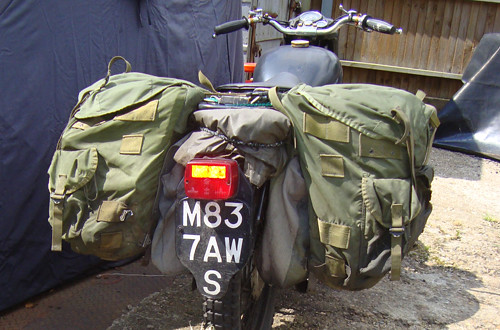 Austin Vince's $35 pannier system (courtesy U.S. government surplus)
Austin Vince's $35 pannier system (courtesy U.S. government surplus)
Brian DeArmon is the thinking rider’s rider. Every equipment choice he makes is the result of not just long experience as a motorcyclist, but extensive research into pros and cons, competing brands, and above all, quality. Generally when Brian adds something to one of his bikes, that’s the last you hear about it, because it works. Given all that, it was no surprise that his detailed response more or less summarized my conclusions before I even reached any.
“Short version: Bigger bikes that are being used on easy to moderate terrain, with predictable weather conditions, I tend to favor hard bags (primarily for the security and ease of access). For small bikes, or any bike going where trail conditions are unknown, I prefer soft bags.
Long version:
Suspension: It’s too easy to overload a small bike already. Add in 15 or 20 pounds for the hard panniers and mounting brackets, you eat into valuable capacity. The big bikes are better able to handle those loads. Unfortunately, hard panniers also make it real easy to strap even more crap on the bike since they typically create a nice big surface area & include those nice tie down points.
Power: Smaller bikes typically don't have the power to push big loads down the road at the speeds required in the west. I've ridden the DR200 on the freeway with no load, and it’s kinda scary, even in the slow lane. I couldn't imagine doing it with an extra 40 pounds of pannier/gear/food/water (state highways and back roads, sure, just not freeways where traffic is moving 70 to 80 mph). Put that load on a GSA or big KTM and you don't have the same problem.
Trail conditions: On relatively tame roads, in known weather conditions, hard panniers are not much of a liability, IMO. The risk of crashing isn't that high. But once conditions become unknown, or weather conditions make a turn towards the wet side (mud), hard panniers become a huge liability. There is the obvious danger of tib/fib breaks, but also damage to the bike itself. My GS has a bent subframe caused by smacking a pannier on a rock. That is hardly a concern with soft bags.
Security and Convenience: Hard bags have a hands-down advantage for security and ease of use. Dump in your gear, close the lid, lock the latch, and you’re done. They’re typically easy to dismount and move into a hotel room, etc. Soft bags often have a convoluted mess of straps that makes it more difficult to access gear and install or remove. Soft bags also need to be checked regularly as loads change and straps loosen. Of course there is also the problem of having nothing between your gear and a thief but a knife.
Basically, I see soft bags as the default luggage system, with hard bags being a legitimate option if certain conditions are met.”
Nicole Espinosa didn’t like the racks available for the Suzukis she rides, so she made her own. Now she runs a business, Rugged Rider, which specializes in high-quality accessories for the reliable and overachieving small DRZs. Nicole wrote: “I feel the DRZ400 is the perfect bike to set up for adventure. It has a strong enough engine to maintain a comfortable 70 MPH on the highway, and is a nimble enough size to have fun on tight single-track fully loaded. That said, I prefer soft luggage for a tighter profile on highway against wind, and on trails for width. I only keep my clothes and rain gear in my Ortleib dry side bags, and have only traveled in North America as of yet, so I haven’t put the security of soft bags to the test internationally. I keep my expensive gear in my tank bag that I can carry with me or ratchet down on my locking combo luggage rack.”
All you need to know about Doug Mote as a rider is summed up below in his reference to “easy going.” Anything else I’d add would be superfluous, except to say he’s one of the nicest guys I know (despite his comment about kicking KTM ass). As a lumberjack and body double for Paul Bunyan, Doug was at the far end of my bell curve for big riders with big bikes. He sent: “I have hard and soft luggage, and use both. My preference depends on itinerary. For easy going, like say a run to Prudhoe Bay on a schedule, hard bags offer several advantages, not the least of which is better weather protection. On this type of good road trip in wide open spaces, there is little risk of leg or foot injury such as I have witnessed friends incurring when trapped between bag and earth. For tough going, where lightness and flexibility are key, soft luggage is superior. Spills are not so risky, and my entire kit weighs less than empty hard bags with mounting racks. I use only soft bags on the 650, either soft or hard with the 1150 depending on the route and how much KTM ass there is to kick. For extended travel with diverse route conditions, soft luggage is my clear choice."
I won’t claim that Bruce Douglas sometimes uncovers a motorcycle in his yard he’s forgotten he owns, but he does own a lot of them, and has based his transportation on motorcycles since his very first vehicle, a two-stroke Yamaha 360. His main backroad bike is a thoughtfully modified Suzuki DR650. Bruce wrote: “I’d say hard cases for security, appearance, and good mounting surface for other stuff. I think they’d be fine if I knew I wouldn’t be riding through any difficult terrain, but if there was a chance I might go down I’d have to go with soft bags. A few times when I’ve put my foot down while moving on the TransAlp I had it get caught under the hard case. It was clear how easily you could break something—and it wouldn’t be the case. I think I’m sold on soft bags now after the Baja trip. I like their versatility; I can use different bags with my mounts, since the main function of most mounts is to keep the bags away from the rear wheel. I’m happy with what I have, they’re simple and straight forward. The Wolfman Gen 2 mounts are interesting: a little complicated but they add more mounting points, and a means to carry extra fuel. Also knowing I can repair them with a sail needle and thread is nice. In a spill they flex, rather than dent. If the mounting straps tear off you can come up with a repair, or just tie it on with cord. The chance of the mounts coming out of hard cases is slim, but if they did, a field repair would be difficult. Soft bags aren’t as secure, but after undoing a few straps you can pull them off as saddle bags and carry them over your shoulder (a la John Wayne). In Baja I was able to carry all my gear in one trip: saddle bags on my shoulder, the tail bag in one hand, and whatever in the other hand. Soft bags also make you think about packing and not be tempted to just dump stuff into metal boxes.”
And finally, from Kevan Harder, a California police and SWAT officer who also works for RawHyde Adventures, where it often seems motorcycles are defined as BMW or . . . everything else . . . comes a firm vote for the red corner of the chart: “I strongly recommend hard bags for durability, protection of gear, and versatility (bike service stand, chair, table, etc).”
So there you have it, courtesy of some of the most experienced riders on the planet: an easy way to determine what type of motorcycle luggage will best suit you, your bike, and your riding.
Think this will end all those forum debates?
No poseur machine: Tiffany Coates' R80GS, Thelma
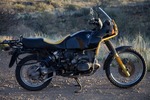 When legendary motorcycle world traveler Tiffany Coates was in the U.S. for a speaking tour in 2010, BMW Motorrad USA offered to pay for parts and repairs on her 20-year-old R80GS, Thelma, which by then had carried her well over 150,000 miles on five continents.
When legendary motorcycle world traveler Tiffany Coates was in the U.S. for a speaking tour in 2010, BMW Motorrad USA offered to pay for parts and repairs on her 20-year-old R80GS, Thelma, which by then had carried her well over 150,000 miles on five continents.
When Tiffany told her father the good news, his response was, “Bloody hell—had they seen the bike when they offered that?”
 When legendary motorcycle world traveler Tiffany Coates was in the U.S. for a speaking tour in 2010, BMW Motorrad USA offered to pay for parts and repairs on her 20-year-old R80GS, Thelma, which by then had carried her well over 150,000 miles on five continents (TiffanysTravels.co.uk).
When legendary motorcycle world traveler Tiffany Coates was in the U.S. for a speaking tour in 2010, BMW Motorrad USA offered to pay for parts and repairs on her 20-year-old R80GS, Thelma, which by then had carried her well over 150,000 miles on five continents (TiffanysTravels.co.uk).
When Tiffany told her father the good news, his response was, “Bloody hell—had they seen the bike when they offered that?”
Indeed. A close (i.e. anything nearer than 50 feet) inspection of Thelma indicates that Tiffany pays diligent attention to the mechanical aspects of the bike, and pretty much files aesthetics under “patina.” A good third of the bumblebee yellow paint on the front guard seems to have been left in flakes in foreign countries, and various scrapes, gouges, blobs of third-world welds, and fraying wraps of duct tape attest to the drops and general wear unavoidable in the course of accumulating the spectacular CV of this motorcycle and its rider.
Tiffany will be at the 2012 Overland Expo, teaching classes in personal safety for women, contributing to regional travel forums and experts panels, and presenting a talk and slide show on central Asia.
Meanwhile, here’s a close look at Thelma, who’s been enjoying a break parked at the Overland Expo headquarters outside Tucson. If you haven’t yet seen Tiffany’s BMW Unscripted video clip, watch it here: http://www.youtube.com/watch?v=XAUhV1r-kUo
 A bit of road wear is apparent on the lamp guard
A bit of road wear is apparent on the lamp guard Crash bars have some stories to tellThe modifications to Thelma are scant. Besides the much-repaired hard luggage mounts, here’s a comfortable Bill Mayer saddle, a custom Wilbers Suspension rear spring and shock, and, well . . . that’s about it.
Crash bars have some stories to tellThe modifications to Thelma are scant. Besides the much-repaired hard luggage mounts, here’s a comfortable Bill Mayer saddle, a custom Wilbers Suspension rear spring and shock, and, well . . . that’s about it.
 Running gear is virtually stock
Running gear is virtually stock Single non-vented disc brake in front, drum in rear
Single non-vented disc brake in front, drum in rear
 Hey, it still blinks . . .
Hey, it still blinks . . .
 Underside shows the effects of 200,000 overland miles
Underside shows the effects of 200,000 overland miles Weld repairs would give a German engineer nightmares
Weld repairs would give a German engineer nightmares But Mickey seems happy to ride along . . .
But Mickey seems happy to ride along . . .
Touring tip: When it's tool time on the road
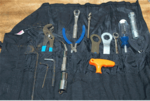 Published with the permission of RoadRUNNER Motorcycle Touring & Travel Magazine for Overland Tech & Travel / Overland Expo only. Not for sale or distribution.
Published with the permission of RoadRUNNER Motorcycle Touring & Travel Magazine for Overland Tech & Travel / Overland Expo only. Not for sale or distribution. If you’re like most adventure motorcyclists, you don’t want any type of mechanical problem to deal with during a motorcycle tour. And, of course, the best way to keep that from happening is a heavy dose of preventative medicine before your bike ever leaves the garage. But unforeseen mechanical malfunctions can and do happen out on the road. So, taking selected tools with you and knowing how to use them are sensible precautions for any touring rider.
If you’re like most adventure motorcyclists, you don’t want any type of mechanical problem to deal with during a motorcycle tour. And, of course, the best way to keep that from happening is a heavy dose of preventative medicine before your bike ever leaves the garage. But unforeseen mechanical malfunctions can and do happen out on the road. So, taking selected tools with you and knowing how to use them are sensible precautions for any touring rider.
Key Assumptions: If you ask 10 different riders for their list of necessary tools to have along, you may get 10 different lists. That’s probably because of the assumptions each person is making in several key areas:
- Length of Trip: The longer you expect to be on the road the more likely it is that something on the bike will need repair. If your trip involves going around the globe, then many more tools and spare parts will be needed than for a weekend jaunt to the mountains.
- Type of Bike & Riding: All other things being equal, dual-sport riding and adventure touring are more likely to result in something coming loose or a bike going down than while street riding.
- Riding Environment: Riding in remote locations usually requires riders to be more self-reliant in fixing whatever needs repairing.
- Number of Riders in the Group: The solitary rider must carry all of the tools and spare parts he or she might need. In group riding situations the load can be spread amongst the riders.
- Mechanical Expertise of Rider(s): There’s no point in carrying a lot of tools and spare parts if you don’t know how to use them to make the repairs. Riders traveling long distances in remote areas, however, should have the requisite mechanical expertise and equipment to repair most any type of mechanical malfunction.
 Published with the permission of RoadRUNNER Motorcycle Touring & Travel Magazine for Overland Tech & Travel / Overland Expo only. Not for sale or distribution.
Published with the permission of RoadRUNNER Motorcycle Touring & Travel Magazine for Overland Tech & Travel / Overland Expo only. Not for sale or distribution. If you’re like most adventure motorcyclists, you don’t want any type of mechanical problem to deal with during a motorcycle tour. And, of course, the best way to keep that from happening is a heavy dose of preventative medicine before your bike ever leaves the garage. But unforeseen mechanical malfunctions can and do happen out on the road. So, taking selected tools with you and knowing how to use them are sensible precautions for any touring rider.
If you’re like most adventure motorcyclists, you don’t want any type of mechanical problem to deal with during a motorcycle tour. And, of course, the best way to keep that from happening is a heavy dose of preventative medicine before your bike ever leaves the garage. But unforeseen mechanical malfunctions can and do happen out on the road. So, taking selected tools with you and knowing how to use them are sensible precautions for any touring rider.
Key Assumptions: If you ask 10 different riders for their list of necessary tools to have along, you may get 10 different lists. That’s probably because of the assumptions each person is making in several key areas:
- Length of Trip: The longer you expect to be on the road the more likely it is that something on the bike will need repair. If your trip involves going around the globe, then many more tools and spare parts will be needed than for a weekend jaunt to the mountains.
- Type of Bike & Riding: All other things being equal, dual-sport riding and adventure touring are more likely to result in something coming loose or a bike going down than while street riding.
- Riding Environment: Riding in remote locations usually requires riders to be more self-reliant in fixing whatever needs repairing.
- Number of Riders in the Group: The solitary rider must carry all of the tools and spare parts he or she might need. In group riding situations the load can be spread amongst the riders.
- Mechanical Expertise of Rider(s): There’s no point in carrying a lot of tools and spare parts if you don’t know how to use them to make the repairs. Riders traveling long distances in remote areas, however, should have the requisite mechanical expertise and equipment to repair most any type of mechanical malfunction.
Most Common Malfunctions on the Road
It behooves all riders to have the necessary tools and skills to fix the motorcycle malfunctions that are most likely to occur on tour:
- Flat Tire: For tubeless tires, there are a number of kits available in the marketplace that enable riders to perform a temporary repair, without removing the tire from the bike. Besides the CO2 cartridges that come with these kits, it’s a good idea to have a small compressor to ensure that the re-inflated tire has sufficient pressure for safe riding. (You’ll need a tire pressure gauge to know for sure.) However, riders should have a professional technician repair or replace the tire as soon as possible.
For tube-type tires, the repair process is more involved and requires more tools. (Helpful hint: Even if a tire is marked “tubeless” on the outside, if it’s mounted on a spoke wheel, a tube will be required on the inside.) The wheel and tire must be removed from the bike, so the necessary wrenches should be on board for both the front and rear axles. Tire irons and a bead buster will be needed to remove the tube for repair or replacement.
- Electrical Malfunction: The most common types of electrical problems are blown fuses and burned out light bulbs. So, it’s important to know where the fuses are located on the bike and to have spares with the correct wattage. Also, it’s a good idea to carry extra bulbs for the headlight, taillight and turn signals, and to have the correct tools and expertise to replace them.
- Broken Cable(s) and Levers(s): Broken cables are a potential issue only on bikes with a manual clutch (i.e., non-hydraulic) or drum brakes. In these situations, carry an extra cable(s) already zip-tied in place with the one in use. This will dramatically reduce repair time if a cable breaks.
A broken clutch or brake lever, usually caused by a fall, can be a big problem on the road. Although the risk of a broken brake lever is somewhat hedged by the fact that there are two of them, there is only one clutch lever and it’s pretty hard to ride a motorcycle without the benefit of a clutch. Consequently, taking extra levers is a good insurance policy.
- Fouled Spark Plug(s): It’s always a good idea to have extra spark plugs, which have been pre-gapped, along on your trips. They don’t take up much space and can make the difference of whether you're stranded or not. Obviously, the proper wrenches will be needed to replace them.
- Low Motor Oil: If your bike has a history of using oil, it makes a lot of sense to take along a quart of motorcycle oil, which might otherwise be difficult to find on a Sunday, Monday or Holiday.
- Broken Bodywork: Sometimes a spill can leave cracked and loose body parts, which can make the motorcycle unsafe to ride. A roll of duct tape can often do wonders in these situations.
The above list is not an exhaustive one, but it does represent the type of malfunctions that could occur on a trip of several weeks.
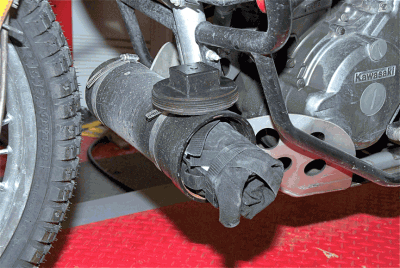 Customizing Your Toolkit
Customizing Your Toolkit
Unfortunately, the tool kits that come with bikes are often of inferior quality. You don’t want a wrench breaking or rounding off a nut when you’re relying on it to get you out of a predicament. Consequently, I’m an advocate of building a customized toolkit that’s designed around the type of repairs you may have to perform on the road. Based on the key assumptions about your touring plans and the types of repairs that are likely to occur, acquire the specific, high quality sockets, ratchets, screwdrivers and other wrenches that are needed to perform these tasks. It’s OK to use items from the manufacturers toolkit if they’re of sufficient quality. To make sure you have what’s needed, use your tool kit while still at home to remove the wheels, change a spark plug, replace a light bulb, etc.
I found that the customized tool kit for my dual-sport bike would no longer fit under the seat, so I fashioned a separate container out of PVC pipe and mounted it on the skid plate. So far I’ve been able to make any needed repairs on the road - but the best tools to have along are still a cell phone and a credit card.
Published with the permission of RoadRUNNER Motorcycle Touring & Travel Magazine for Overland Tech & Travel / Overland Expo only. Not for sale or distribution.
Hint: When using “Search,” if nothing comes up, reload the page, this usually works. Also, our “Comment” button is on strike thanks to Squarespace, which is proving to be difficult to use! Please email me with comments!
Overland Tech & Travel brings you in-depth overland equipment tests, reviews, news, travel tips, & stories from the best overlanding experts on the planet. Follow or subscribe (below) to keep up to date.
Have a question for Jonathan? Send him an email [click here].
SUBSCRIBE
CLICK HERE to subscribe to Jonathan’s email list; we send once or twice a month, usually Sunday morning for your weekend reading pleasure.
Overland Tech and Travel is curated by Jonathan Hanson, co-founder and former co-owner of the Overland Expo. Jonathan segued from a misspent youth almost directly into a misspent adulthood, cleverly sidestepping any chance of a normal career track or a secure retirement by becoming a freelance writer, working for Outside, National Geographic Adventure, and nearly two dozen other publications. He co-founded Overland Journal in 2007 and was its executive editor until 2011, when he left and sold his shares in the company. His travels encompass explorations on land and sea on six continents, by foot, bicycle, sea kayak, motorcycle, and four-wheel-drive vehicle. He has published a dozen books, several with his wife, Roseann Hanson, gaining several obscure non-cash awards along the way, and is the co-author of the fourth edition of Tom Sheppard's overlanding bible, the Vehicle-dependent Expedition Guide.







